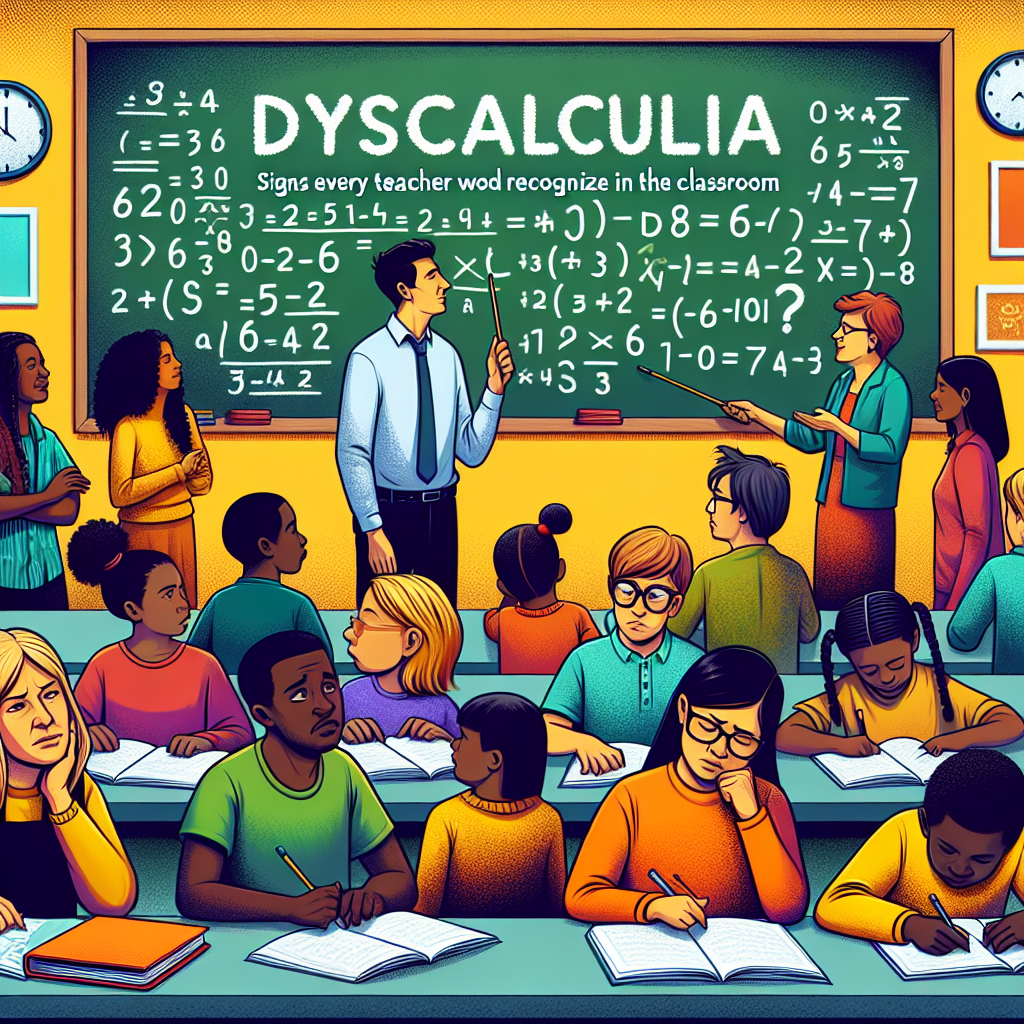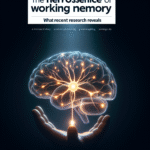
Dyscalculia: Signs Every Teacher Should Recognize in the Classroom for Effective Support
Introduction
In today’s diverse educational landscape, classrooms are filled with students showcasing unique strengths and challenges. Among these challenges is dyscalculia, a learning difference that affects a significant number of students, yet remains under-recognized and misunderstood within the educational community. As teachers, recognizing dyscalculia: signs every teacher should recognize in the classroom is crucial—not only to foster an inclusive environment but also to equip our students with the skills they need to thrive academically.
This article will delve deep into dyscalculia, outlining its signs, offering actionable strategies for identification, and providing case studies to enlighten teachers about practical applications. Let’s embark on this enlightening journey to better understand our learners and enrich their educational experiences.
What is Dyscalculia?
Dyscalculia is a specific learning difficulty that primarily impacts a student’s ability to understand numbers and perform mathematical calculations. Often described as "math dyslexia," dyscalculia affects approximately 5-7% of the population. Individuals with dyscalculia may struggle not only with basic arithmetic but also with understanding more complex mathematical concepts, which can cascade into broader academic challenges.
Key Characteristics of Dyscalculia
- Difficulty Understanding Numerical Concepts: Many students find it hard to grasp the concept of numbers and quantities.
- Challenges with Basic Arithmetic: Struggles with addition, subtraction, multiplication, and division are common.
- Memory Issues with Mathematical Facts: Students may have difficulty recalling math facts like times tables.
- Trouble with Time and Measurement: Understanding time intervals, measuring lengths, and managing schedules can be problematic.
Common Misconceptions
Before delving deeper into the dyscalculia: signs every teacher should recognize in the classroom, it’s essential to address some misconceptions. Dyscalculia is not just a problem of poor teaching or lack of effort. It’s a genuine learning difference rooted in cognitive processing issues. Teachers must be aware of these nuances to provide appropriate support.
Signs of Dyscalculia: What to Look Out For
Identifying students with dyscalculia can often feel like searching for a needle in a haystack. However, certain indicators can shine a light on potential challenges. Below, we outline critical dyscalculia: signs every teacher should recognize in the classroom.
1. Frequent Errors with Math Operations
Students may repeatedly make mistakes even on simple problems. For instance, if a student frequently adds 7 + 5 as 12 instead of the correct 12, it may be indicative of underlying issues.
2. Reliance on Fingers or Objects
Many students with dyscalculia continue to use counting objects or fingers to solve simple math problems well into higher grades. If a student struggles to move beyond physical counting methods, it could be a warning sign.
3. Inconsistent Number Concept Understanding
A student might grasp the concept of addition but falter when faced with subtraction. This inconsistency often points to dyscalculia and should prompt further investigation.
4. Difficulty with Place Value
Students may confuse numbers that are in different places—mixing up a number such as 34 for 43, for example. This difficulty can complicate understanding larger numbers and basic math operations.
5. Trouble Reading Clocks and Understanding Time
If a student struggles to read an analog clock or calculate elapsed time, these can be essential signals of dyscalculia that teachers should not ignore.
6. Poor Spatial Awareness
Signs such as difficulty in aligning numbers in calculations or problems with managing space in their notebooks can also indicate the presence of dyscalculia.
Table: Quick Reference Guide to Signs of Dyscalculia
| Signs | Description |
|---|---|
| Frequent Errors | Simple arithmetic mistakes on basic problems |
| Use of Fingers | Relying on physical counting methods |
| Inconsistent Understanding | Grasping some concepts while struggling with others |
| Difficulty with Place Value | Confusing tens and units |
| Trouble with Time | Challenges in reading clocks or calculating time |
| Poor Spatial Awareness | Difficulty in aligning numbers or organizing work |
The Importance of Early Identification
Recognizing dyscalculia: signs every teacher should recognize in the classroom is critical for effective intervention. Early identification allows for tailored learning strategies, enabling students to develop confidence and proficiency in mathematics. Teachers are in a unique position to observe these signs and facilitate timely support.
Strategies for Intervention
Once teachers identify the signs of dyscalculia, the next step is to implement effective strategies to help these students. Here are some approaches that can make a significant difference:
1. Use of Visual Aids
Visual aids such as number lines, charts, and manipulatives can help students visualize mathematical concepts. By making abstract ideas tangible, these tools can enhance comprehension and retention.
2. Encourage Mental Math
While students with dyscalculia might struggle with mental calculations, fostering a supportive environment that encourages practice can help develop this skill over time. Use games and fun challenges to motivate students.
3. Provide Step-by-Step Instructions
Breaking down tasks into smaller steps can aid students in grasping complex concepts. For example, teach multi-step problems one step at a time, allowing students to practice each stage thoroughly.
4. Incorporate Technology
Numerous apps and online resources cater to students with math difficulties. Use these tools to create an interactive and engaging learning environment.
5. Foster a Positive Math Culture
Promote a mindset that celebrates mistakes as learning opportunities. Encourage students to share their thought processes, which can help demystify math concepts.
Case Studies
Case Study 1: Emily and the Number Line
Background: Emily, a fifth-grader, struggled immensely with addition and subtraction.
Observation: Her teacher noticed she frequently got basic problems wrong. Emily relied on her fingers for counting, even solving simple problems.
Interventions: The teacher introduced a number line to help Emily visualize the addition process which gradually boosted her confidence. Over weeks, Emily moved from using physical counting to accurately solving problems mentally.
Analysis: This case illustrates the power of visual aids in augmenting understanding. Teachers can replicate such strategies in their classrooms to support similar learners.
Case Study 2: Jake and Digital Tools
Background: Jake, a high school student, found mathematics overwhelmingly challenging and showed significant frustration in class.
Observation: Despite showing strong analytical skills in other subjects, Jake’s difficulty with time management and arithmetic was evident.
Interventions: His teacher integrated educational apps into his learning routine, allowing Jake to practice math in engaging ways that suited his learning style.
Analysis: The successful use of technology showcases the importance of differentiated instruction. Tailoring learning to individual students can lead to remarkable progress.
Conclusion
Understanding dyscalculia: signs every teacher should recognize in the classroom is essential for fostering an inclusive and supportive learning environment. By identifying the signs early, implementing effective intervention strategies, and fostering a positive learning culture, educators can make a profound difference in the lives of students facing these challenges.
As we reflect on our roles as educators, let’s commit to recognizing and supporting our learners with dyscalculia. Each child has the potential to succeed—that potential just requires the right tools and support.
FAQs
1. What is dyscalculia?
Dyscalculia is a specific learning difficulty affecting an individual’s ability to understand numbers, perform calculations, and grasp mathematical concepts.
2. How can I identify dyscalculia in my students?
Look for signs such as frequent errors in math operations, reliance on counting objects, trouble with place value, and difficulty reading clocks.
3. Are there specific teaching strategies for students with dyscalculia?
Yes, strategies include using visual aids, providing step-by-step instructions, incorporating technology, and fostering a positive classroom environment focused on learning.
4. At what age can dyscalculia be diagnosed?
Dyscalculia can often be identified in early childhood, but many students are not diagnosed until later grades when math becomes more complex.
5. Can dyscalculia co-occur with other learning difficulties?
Yes, it is common for dyscalculia to co-occur with other learning difficulties such as dyslexia or ADHD, affecting students in multiple areas of learning.
6. What resources are available for teachers and parents?
Various resources, including apps, online programs, and professional development courses, are available to support teachers and parents in addressing dyscalculia. Organizations like the International Dyslexia Association provide information and resources.
By exploring the signs of dyscalculia and taking proactive steps for support, we contribute to transforming our classrooms into spaces where every student has the opportunity to excel.
















